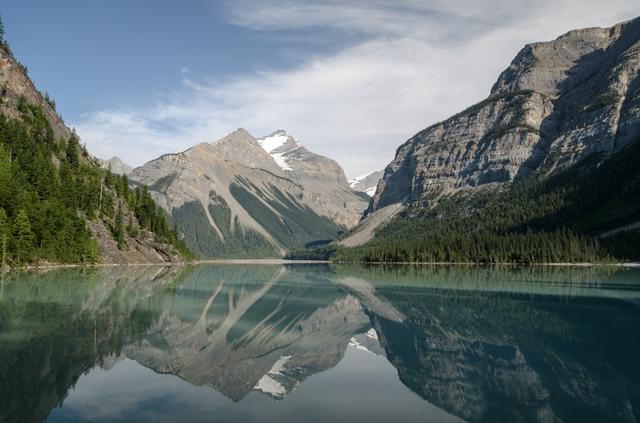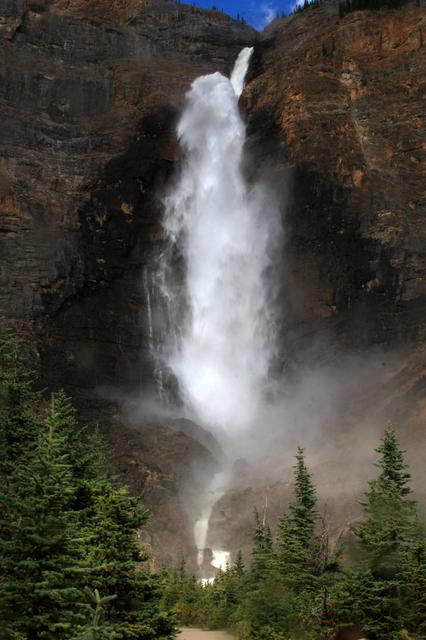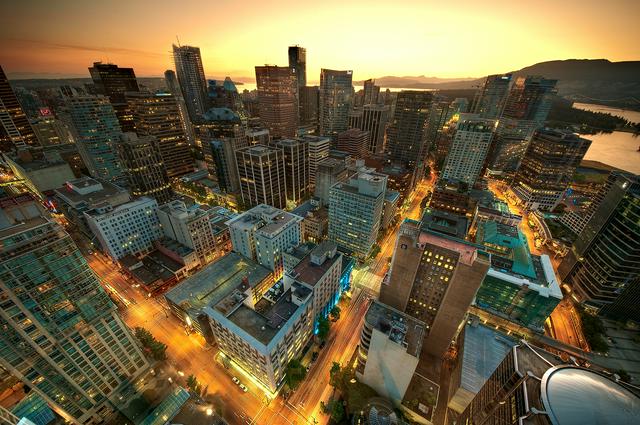British Columbia (BC) is a western province of Canada, between the Pacific Ocean, and the Rocky Mountains. British Columbia is about four times the size of Great Britain with 4.6 million inhabitants.
Several north-south mountain ranges cross through the province, such as the Rockies, the Selkirks, the Purcells and the Coastal Range.
BC has great scenery along the coast and inland, and is a rewarding destination for outdoor life, especially downhill snowsports and wilderness backpacking.
It is a land of contrasts with the metropolis of Vancouver, a progressive global hotspot, against a rich backdrop of the heritage of the First Nations of British Columbia.
Listed below are just nine of the province's most notable urban destinations. Links to others will be found in the various regional articles.
- Vancouver. is by far the largest city in British Columbia, and the largest metropolitan area west of Toronto.
- Victoria. is the provincial capital, on the south tip of Vancouver Island.
- Kamloops. is called the tournament Capital of Canada.
- Kelowna. is the largest city in the British Columbia interior.
- Nelson. is "The Queen City" of the Kootenays, renowned for its tourism, culture and outdoor activities.
- Penticton. is a popular summer destination on Okanagan Lake.
- Prince George. is the largest city in Northern British Columbia and the center of the BC Forest Industry.
- Prince Rupert., Canada's rainiest city, is the hub of the North Coast.
- Whistler. is a summer and winter outdoor destination and the site of many events in the 2010 Winter Olympics.
Vancouver. is by far the largest city in British Columbia, and the largest metropolitan area west of [[Toronto]].
Victoria. is the provincial capital, on the south tip of Vancouver Island.
Kamloops. is called the tournament Capital of Canada.
Kelowna. is the largest city in the British Columbia interior.
Nelson. is "The Queen City" of the Kootenays, renowned for its tourism, culture and outdoor activities.
Penticton. is a popular summer destination on Okanagan Lake.
Prince George. is the largest city in Northern British Columbia and the center of the BC Forest Industry.
Prince Rupert., Canada's rainiest city, is the hub of the North Coast.
Whistler. is a summer and winter outdoor destination and the site of many events in the 2010 Winter Olympics.
 With its abundance of mountains, coastline and wilderness, British Columbia has many destinations outside of its cities and towns. Listed below are nine of the province's most notable other destinations.
With its abundance of mountains, coastline and wilderness, British Columbia has many destinations outside of its cities and towns. Listed below are nine of the province's most notable other destinations.
- Glacier National Park.
- Gwaii Haanas National Park Reserve.
- Kootenay National Park.
- Manning Provincial Park.
- Mount Robson Provincial Park.
- Pacific Rim National Park Reserve.
- Salt Spring Island.
- Tatshenshini-Alsek Provincial Park.
- Yoho National Park.
Glacier National Park.
Gwaii Haanas National Park Reserve.
Kootenay National Park.
Manning Provincial Park.
Mount Robson Provincial Park.
Pacific Rim National Park Reserve.
Salt Spring Island.
Tatshenshini-Alsek Provincial Park.
Yoho National Park.
_a_Kwakwaka'wakw_big_house-LbiQW.medium.jpg) BC was the sixth province to join the Confederation of Canada, in 1871. This was done at least partly on the basis of a promise by the Federal Government to build a railway linking BC to the rest of Canada. Significant geographical barriers and political feuding delayed the completion of this railway until 1885 when the last spike was driven home at a place called Craigellachie in the Eagle Pass area in the interior of BC.
BC was the sixth province to join the Confederation of Canada, in 1871. This was done at least partly on the basis of a promise by the Federal Government to build a railway linking BC to the rest of Canada. Significant geographical barriers and political feuding delayed the completion of this railway until 1885 when the last spike was driven home at a place called Craigellachie in the Eagle Pass area in the interior of BC.
Being on the Pacific, there has always been a strong Asian influence. Many Chinese men arrived in the early part of the 19th century to work in the gold rush of that era and later many more worked on the construction of the railway through the mountains.
The indigenous people of BC have been called Indians or Native Canadians, but now the generally accepted term is First Nations.
Prior to arrival of Europeans BC was a very prosperous area. This was largely due the abundance of salmon. This was demonstrated by the advanced culture that existed in BC. More than thirty languages belonging to seven different language families were spoken in BC. The arrival of Europeans began as a positive relationship. However, the Europeans brought smallpox and other diseases, which decimated the First Nations population.
Many First Nations people were encouraged or even forcibly required to send their children to residential schools during the early to mid 20th century. These schools were government sponsored. The primary intent of the schools was to assimilate the First Nation population. Children were taught that their culture was backward and evil and were not allowed to speak their native languages. This systemic problem is finally being addressed and discussed openly.
Many of the First Nation communities have been trying to revive their culture and are now often the center of much of the ecotourism industry.
With a few exceptions, the First Nations of BC (unlike the rest of Canada) have never signed treaties or ceded their territory to Canada. Therefore, the official ownership of much of the province is contested as the First Nations claim much of the province as their territory. The courts have generally acknowledged that there is a basis for the claims based on historical use of the land and have urged the governments to negotiate a settlement to these claims. Settling these land claims has been a complex issue that is still ongoing. The first modern treaty signed was by the Nis'ga in Northern BC. In 2007, the Tsawassen and Maa-Nulth First Nations signed treaties with the Province and the federal government.
Although Canada is officially a bilingual French/English country, you would be hard pressed to find many French-speaking people in BC. Services are available in English and French at offices of the federal government. Provincial and municipal governments operate in English only. Some businesses, especially in Vancouver and Victoria offer services in a number of languages (primarily Asian ones). Banks sometimes indicate by a sign in the window which languages are offered. Due to the large number of Chinese immigrants, Mandarin, Cantonese and to lesser extent, other Chinese dialects are spoken by many Chinese residents of Vancouver. Some municipal services in Chinese-dominated neighbourhoods may be available in Chinese.
With the migration of people from all over Canada into British Columbia, most citizens here speak with a general Canadian accent while in rural areas, people may speak with a slight twang. At one time Chinook Jargon, a bridge language for trading between English, French and First Nations peoples in the late 1800s and early 1900s, was common and almost became the official language of BC. Now there are very few speakers of the language, but many terms from the language are common slang terms in rural parts of BC.
- Cheechako
- Newcomer, implying "tenderfoot" (more common in Northern BC and the Yukon).
- Saltchuck
- The ocean. Often abbreviated as in "out on the chuck"
- High Muckamuck
- The chief, or boss, or "high pooh-bah"
- Tyee
- king or chief or boss, can also mean a large Chinook salmon
- Cultus
- Bad or worthless, also "ordinary"
- Skookum
- Strong, powerful, or impressive, also just means "big and thick".
- Skookumchuck
- "strong water", used for rapids, especially saltwater rapids

- International Buddhist Temple. In Richmond is the most authentic example of traditional palatial Chinese architecture in North America. It is an edifice straight out of the Chinese past, as it resembles any authentic temple that can be found along the banks of the Yangtze River, where one of the world's oldest civilizations originated. Come explore traditional Chinese art, culture, and the Buddhist philosophy inside this magnificent place. Free admission.
- Yoho National Park is in eastern BC bordering Banff National Park on the Trans Canada Highway.
- Glacier National Park takes in part of the Selkirk Mountain Range where the Trans Canada Highway crosses the range through Roger's Pass.
- Butchart Gardens. Near Victoria offers over 50 acres (22 hectares)of gardens and floral display.
- Stanley Park (Vancouver) — is not just your average urban park! You can stroll through the park on the seawall, check out the aquarium, take a look at the totem poles, and stop at various historical points of interest.
- Royal British Columbia Museum in Victoria
- Science World. Vancouver — nice for kids of all ages. Also has an IMAX Theatre.
- Vancouver Art Gallery Vancouver
- Capilano Suspension Bridge and Park North Vancouver
International Buddhist Temple. In Richmond is the most authentic example of traditional palatial Chinese architecture in North America. It is an edifice straight out of the Chinese past, as it resembles any authentic temple that can be found along the banks of the Yangtze River, where one of the world's oldest civilizations originated. Come explore traditional Chinese art, culture, and the Buddhist philosophy inside this magnificent place. Free admission.
[[Yoho National Park]] is in eastern BC bordering [[Banff National Park]] on the Trans Canada Highway.
[[Glacier National Park (British Columbia)|Glacier National Park]] takes in part of the Selkirk Mountain Range where the Trans Canada Highway crosses the range through Roger's Pass.
Butchart Gardens. Near [[Victoria (British Columbia)#See|Victoria]] offers over 50 acres (22 hectares)of gardens and floral display.
Stanley Park ([[Vancouver#See|Vancouver]]) — is not just your average urban park! You can stroll through the park on the seawall, check out the aquarium, take a look at the totem poles, and stop at various historical points of interest.
Royal British Columbia Museum in [[Victoria (British Columbia)#See|Victoria]]
Science World. [[Vancouver#See|Vancouver]] — nice for kids of all ages. Also has an IMAX Theatre.
Vancouver Art Gallery [[Vancouver#See|Vancouver]]
Capilano Suspension Bridge and Park [[North Vancouver#See|North Vancouver]]
- Backpack the West Coast Trail, the Juan de Fuca Marine Trail closer to Victoria, or the BC sections of the Trans Canada Trail.
- Kayak Desolation Sound, Telegraph Cove, the Broken Islands, the Queen Charlotte Islands.
- Scramble the Rockies!
- Rock climb the world-famous Stawamus Chief in Squamish.
- Winter surfing in Tofino.
- Go skiing at Whistler-Blackcomb, North America's largest ski area, or the other excellent ski areas throughout the province in destinations near Kimberley, Fernie, Nelson, Kelowna or Rossland.
- Roam the open range on horseback or try world-class fly-fishing in the Cariboo-Chilcotin.
The legal drinking age in BC is 19.
Beer, wine and spirits are available from the government liquor stores (BCL). They are also available from private beer and wine stores which are usually associated with pubs or bars. Most BCL stores close at 8PM while most private liquor stores are open until 11PM. You cannot buy alcohol in grocery stores.
BC is home to a number of breweries, including the Columbia Brewery in Creston which brews Kokanee, the Granville Island Brewery in Vancouver and Nelson Brewing Company in Nelson. Most breweries offer tours.
BC is also well-renowned for its wine and the Okanagan Valley is the centre of the wine industry in the province. It's a perfect area to visit during the Autumn grape harvest. Many wineries are open for tastings.
 Outside of the metropolitan areas, much of BC is pretty remote. The more remote the area, the better prepared you need to be.
Outside of the metropolitan areas, much of BC is pretty remote. The more remote the area, the better prepared you need to be.
If you are thinking of travelling off designated ski or snowmobile trails always take an avalanche safety course. Travel with experienced guides, talk to locals, look at the Canadian Avalanche Centre's forecast. Or best of all, just play it safe and ski at one of BC's great ski resorts.
Outside the winter months always inform yourself about local concerns with carnivorous wildlife, i.e., bears and cougars. If you're in the BC woods, you can assume that there are likely bears and other wildlife in the area. You're in their territory and it's good practice to make noise and keep your eyes (and ears) open. Knowing how to avoid wildlife encounters is a good idea.
Petty property crime is a problem in the major cities, as it is in most, so don't leave items visible in a vehicle. Violent crime is relatively infrequent. Simple precautions will normally preclude a brush with crime. A problem area for tourists to avoid is the infamous East Hastings area of Vancouver.
Experiments with late bar/nightclub closing times (4AM) have also led to increased problems and violence on Granville Street in downtown Vancouver (especially on weekends).
Close to 20 women have been killed or are missing along the "Highway of Tears" (Highway 16) between Prince George and Prince Rupert since about 1970. Young women might want to avoid hitch-hiking along this highway, especially if you are alone. As of late July, 2019, travel on the Alaska and Cassiar Highways in northern British Columbia is not recommended. However, an alternate option for travel between Alaska and the lower United States is the Alaska Marine Highway between Bellingham in Washington State and Haines in Alaska.
The use and possession of recreational marijuana is legalized in all of Canada on October 17, 2018. However, there are strict anti-smoking bylaws that apply. Avoid flaunting your use -- do not walk down the street smoking, use in a busy park, or talk loudly about your use in public. British Columbia has strict anti-smoking regulations against any kind of indoor smoking so lighting up in a bar or nightclub will get you in trouble with staff and other patrons. Pot cafes in Vancouver often provide a smoking room where you can safely and discreetly indulge; however, unlike their Amsterdam counterparts, they will not sell you marijuana.
To the south is Washington (state) in the U.S.A. which is home to the Olympic Peninsula, Mount Ranier National Park, the North Cascades mountain range, a highly developed agricultural region and the vibrant cities of Seattle-Tacoma on the Pacific coast.
To the east is the province of Alberta which is home to a beautiful mix of prairie, boreal forest and mountains and an economy that fluctuates with the price of oil. It is also home to the cities of Edmonton (the provincial capital) and Calgary (a self-styled cow-town). The mountain towns of Banff, Lake Louise and Jasper are popular and busy in all seasons.
To the north is the Yukon Territory, a vast, sparsely-populated wilderness.
